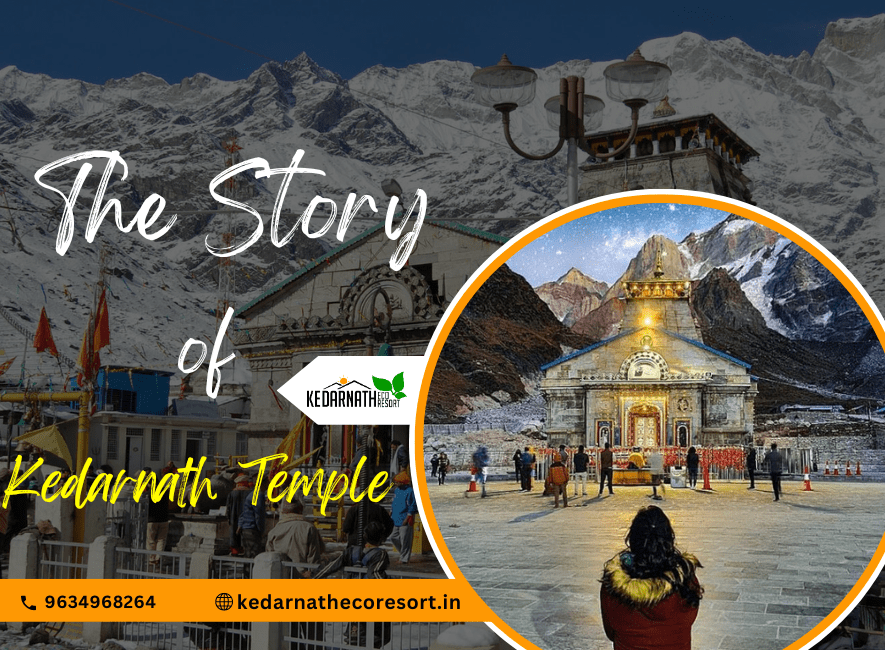Location of Kedarnath Temple
The Kedarnath Temple is the main magnet of the city and Nagar Panchayat of Kedarnath, which is located in the Rudraprayag quarter of Uttarakhand, India. The distance to Rudraprayag, the quarter’s executive centre, is about 86 kilometres. The fourth and furthest down of the four Chota Char Dham passage locales is Kedarnath. It’s positioned in the Himalayas at a height of,583 metres(,755 bases) above ocean position, close to the Chorabari Glacier, the Mandakini swash’s source.
Story of Kedarnath Temple
The Sanskrit words kedara(” field”) and natha(” lord”) are the source of the name” Kedarnath,” which translates to” the lord of the field”(” lord”). According to the Book Kashi Kedara Mahatmya, this is where” the crop of liberation” blooms, which is why it has this name. There are multitudinous folk tales that are told about the creation of the Panch Kedar tabernacles, Lord Shiva, and the Garhwal region. The Pandavas, the protagonists of the Hindu grand Mahabharata, are mentioned in a chronicle called Panch Kedar.
In the notorious Kurukshetra war, the Pandavas subdued and killed their cousins, the Kauravas. They wanted to atone for the fratricide( gotra hatya) and brrahmahatya( payoff of clerk class Brahmins) they had committed during the conflict.
They thus gave their cousins and neighbours the keys to their realm. The Pandavas travelled to the Garhwal Himalayas after failing to find Shiva in Varanasi. The second of the five Pandava sisters, Bhima, also began to search for Shiva while perched atop two mountains. He noticed a bull grazing close to Guptakashi( also known as” retired Kashi” due to Shiva’s act of caching). The bull was incontinently linked by Bhima as Shiva. The bull was seized by the tail and hinder legs by Bhima. still, the bull- shaped Shiva dissolved beneath the earth before making partial reappearances at Kedarnath, Tungnath, Rudranath, Madhyamaheshwar, and Kalpeshwar. The nabhi( nexus) and stomach surfaced at Rudranath, while the face and hair appeared at Rudranath.
The Pandavas constructed tabernacles at each of the five locales to recognize and adore Shiva since they were thrilled with his rejuvenation in five different guises. In a different interpretation of the story, Bhima is credited with not only landing the bull but also precluding its exposure. As a result, the bull was resolve into five pieces and manifested in five different places around the Kedar Khand in Garhwal region of the Himalayas. After constructing the Panch Kedar tabernacles, the Pandavas pondered at Kedarnath for redemption, carried out yagna( fire immolation), and ultimately gained heaven or deliverance by following the godly route known as the Mahapanth( also known as Swargarohini).
The Kedarnath, Tungnath, and Madhyamaheshwar tabernacles and the Panch Kedar tabernacles are erected using the same North Indian Himalayan Temple armature. It’s an verbal religious custom to worship Lord Vishnu at the Badrinath Temple as a last protestation by the sucker that he has sought Lord Shiva’s blessings after completing the passage to admit his darshan at the Panch Kedar tabernacles.
There’s no reference to Kedarnath in the Mahabharata, which recounts the story of the Pandavas and the Kurukshetra War. In the Skanda Purana( about 7th – 8th century), which includes a tale relating the Ganges swash’s morning, Kedarnath is mentioned for the first time. According to the textbook, Shiva let the holy water out of his matted hair at Kedara( Kedarnath).
The 8th- century champion Adi Shankara is said to have passed away in the mounds near to Kedarnath, according to histories grounded on Madhava’s Sankshepa- Shankara- Vijaya, still other histories grounded on Anandagiri’s Prachina- Shankara- Vijaya claim that he passed away in Kanchipuram. At Kedarnath, there are still remnants of a honorary marking the alleged point of Shankara’s demise. By the 12th century, when it’s substantiated in Kritya- kalpataru, a work by the Gahadavala minister Bhatta Lakshmidhara, Kedarnath was really a well- known passage point.
The ancient Brahmins of this area known as Kedarnath Teerth Purohits have been worshipping the lingam since the days of Nara- Narayana and Daksh Prajapati. They’re known as the Rishi- Muni. They’ve been worshipping pilgrims since King Janmejay, a assignee of the Pandavas, granted them the honor to worship at this tabernacle and gift the entire Kedar home.
400 years under the snow!
According to geologists, the Little Ice Age, which lasted from 1300 to 1900 announcement and is also known as this time period, the Kedarnath tabernacle was covered in snow for roughly 400 times. The tabernacle not only lasted 400 times submerged in snow, but also finessed significant detriment from glacial movement.
2013’s Kedarnath flood
Flood tide In 2013, Uttarakhand was devastated by large flash cataracts. 197 people decomposed in the flood tide.,021 people were missing and about 236 were hurt.,119 homes were completely destroyed,,001 were poorly destroyed, and,759 were incompletely destroyed. The city and tabernacle of Kedarnath took the mass of nature’s wrath as well, but the sanctum was unharmed. Some claim that a sizable boulder impeded the water’s inflow and averted the tabernacle from being destroyed. Whether it’s a phenomenon or just beautiful structure, the sanctum is still standing and draws pious people.
Read More about facts of Kedarnath Temple
FAQs related to Kedarnath Temple
What makes Kedarnath so unique?
The Kedarnath passage offers the pleasure of a religious centre and the fizzes of a graphic sightseer destination. It’s notorious for the old tabernacle devoted to Lord Shiva. A peaceful position that’s explosively related to the important Pandavas retains a lovely legend of its own.
What resides within Kedarnath?
The five Pandava sisters, Krishna, Nandi, Shiva’s chariot, and Virabhadra, one of Shiva’s guardians, are all depicted in statues at the Kedarnath Temple’s first hall. In the main hall, there are also statues of Draupadi and other gods.
Who discovered Kedarnath Temple?
According to legend, the original Pandavas constructed the Kedarnath tabernacle, and Adi Shankaracharya erected the current tabernacle while restoring the splendour of the sanctum in the eighth centuryA.D. One of India’s 12 jyotirlingas, the tabernacle is believed to be over,200 times old.




